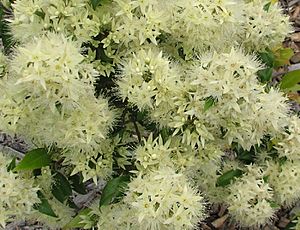Syzygium anisatum facts for kids
Quick facts for kids Syzygium anisatum |
|
|---|---|
 |
|
| Flowers | |
 |
|
| Scientific classification | |
| Genus: |
Syzygium
|
| Species: |
anisatum
|
| Synonyms | |
|
|
Syzygium anisatum, also known as ringwood or aniseed tree, is a special Australian rainforest tree. It is quite rare. Its leaves have a strong, sweet smell, much like real aniseed.
People grow this tree on farms. They use its leaves as a spice in food. They also extract a special oil from the leaves. This oil is called 'aniseed myrtle' or 'anise myrtle' in the market.
Contents
What is Aniseed Myrtle?
Appearance of the Aniseed Myrtle Tree
The ringwood tree has many branches and leaves at the top, forming a thick crown. It can grow very tall, up to 45 metres high.
Its leaves are about 6 to 12 centimetres long. They have wavy edges. If you crush a leaf, it smells strongly of aniseed.
The flowers are white and smell sweet. They grow in clusters called panicles. The fruit are small, dry, and papery capsules. They are about 5 millimetres long and look white.
Where Does Aniseed Myrtle Grow?
In nature, the ringwood tree only grows in a few places. These are the Nambucca and Bellinger Valleys. Both valleys are in the subtropical part of New South Wales, Australia.
How is Aniseed Myrtle Used?
Aniseed Myrtle as a Spice and Tea
People use aniseed myrtle as a spice to flavour food. It is also a popular ingredient in herbal teas. It was first sold as a bushfood spice in the early 1990s. Farmers started growing it in large amounts in the mid-1990s. This helped meet the growing demand for it.
Essential Oil from Aniseed Myrtle
The special oil from Syzygium anisatum contains two main chemicals. These are anethole and methyl chavicol. Anethole gives a licorice flavour. Methyl chavicol adds an aniseed flavour.
The name 'aniseed myrtle' usually means a high-quality oil. This oil has a lot of trans-anethole (over 90%). This type of oil is safe to use for flavouring food. These special plants are grown from cuttings. This makes sure the oil quality stays the same. These aniseed myrtle oils also have very little methyl chavicol and cis-anethole.
Health Benefits of Aniseed Myrtle Oil
Scientists have studied aniseed myrtle oil. They found it can fight against tiny germs. This includes a harmful yeast called Candida albicans.
Threats to Aniseed Myrtle
Understanding Myrtle Rust Disease
A serious plant disease called myrtle rust affects aniseed myrtle. It is caused by a fungus. This fungus is known as Uredo rangelii.
Myrtle rust was first found in aniseed myrtle farms in January 2011. This disease badly damages new plant growth. It is a big threat to growing aniseed myrtle. Scientists are working to find ways to control this disease.
See also
 In Spanish: Syzygium anisatum para niños
In Spanish: Syzygium anisatum para niños

